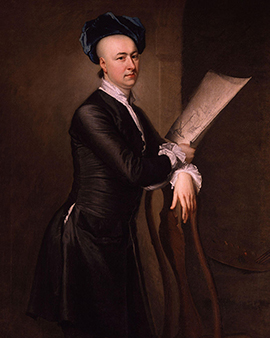


The Briton Samuel Scott was born in London and began painting around 1720, nothing is known about his artistic training. He began as a maritime artist, painting warships and other ships on calm seas in the style of Willem van de Velde, from whom he had many drawings. He also painted, in collaboration with George Lambert, a series of six pictures depicting the settlements of the East India Company. Scott painted the ships, Lambert the buildings and landscape. At the time, Scott was considered one of the "most exalted men of art" in London. At about age 20, Scott began to make sketches of London, especially of the new Westminster Bridge then under construction. When paintings of views of the city became fashionable after Canaletto arrived in London, he began to turn the sketches into oil paintings. He painted at least eleven versions of a view of Old London Bridge. He was still making copies of it 10 years later, when the houses that lined the bridge had been demolished. The images of London Bridge were often painted as one of two pictures, with a picture of the Tower of London or Westminster Bridge as a counterpart.
Between the ages of 40 and 50, he was widely famous for his depictions and exhibited three works at the Society of Artists, one at the Free Society of Artists, and one, "A View of the Tower of London," at the Royal Academy. He was one of the first watercolorists and has been called the father of English watercolor, but his major works are in oils. Some of Scott's most famous paintings were his depictions of scenes from the war of Jenkins' Ear. Scott gained a considerable reputation for his well-drawn and painted riverside and river scenes, which he enlivened with figures. Horace Walpole, who owned a large collection of his works, said that they "will charm in every age" His views of London Bridge, Customhouse Quay, and other pictures of the Thames earned him the name "the English Canaletto."
AT the age of just over 40, Scott first lived in Covent Garden, overlooking the Piazza in Covent Garden. He later moved to Twickenham and then to Ludlow, where his daughter lived, before retiring to Bath, where he died of gout in October at the age of 72, leaving an only daughter. His collection of drawings, prints, etc. was sold by Langford a year after his death.

The Briton Samuel Scott was born in London and began painting around 1720, nothing is known about his artistic training. He began as a maritime artist, painting warships and other ships on calm seas in the style of Willem van de Velde, from whom he had many drawings. He also painted, in collaboration with George Lambert, a series of six pictures depicting the settlements of the East India Company. Scott painted the ships, Lambert the buildings and landscape. At the time, Scott was considered one of the "most exalted men of art" in London. At about age 20, Scott began to make sketches of London, especially of the new Westminster Bridge then under construction. When paintings of views of the city became fashionable after Canaletto arrived in London, he began to turn the sketches into oil paintings. He painted at least eleven versions of a view of Old London Bridge. He was still making copies of it 10 years later, when the houses that lined the bridge had been demolished. The images of London Bridge were often painted as one of two pictures, with a picture of the Tower of London or Westminster Bridge as a counterpart.
Between the ages of 40 and 50, he was widely famous for his depictions and exhibited three works at the Society of Artists, one at the Free Society of Artists, and one, "A View of the Tower of London," at the Royal Academy. He was one of the first watercolorists and has been called the father of English watercolor, but his major works are in oils. Some of Scott's most famous paintings were his depictions of scenes from the war of Jenkins' Ear. Scott gained a considerable reputation for his well-drawn and painted riverside and river scenes, which he enlivened with figures. Horace Walpole, who owned a large collection of his works, said that they "will charm in every age" His views of London Bridge, Customhouse Quay, and other pictures of the Thames earned him the name "the English Canaletto."
AT the age of just over 40, Scott first lived in Covent Garden, overlooking the Piazza in Covent Garden. He later moved to Twickenham and then to Ludlow, where his daughter lived, before retiring to Bath, where he died of gout in October at the age of 72, leaving an only daughter. His collection of drawings, prints, etc. was sold by Langford a year after his death.
Page 1 / 2








